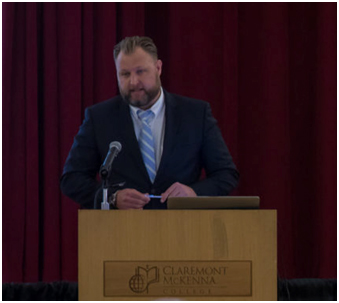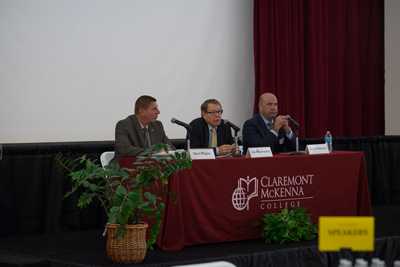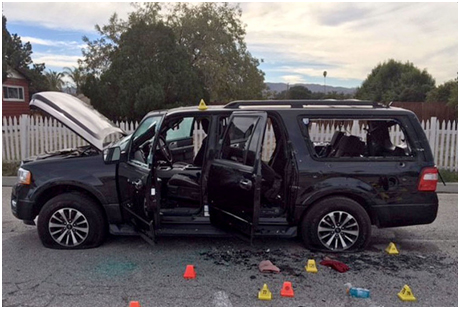Homeland and Security at the Local Level: A Public Policy Conference
Robert J. Bunker, Roger J. Chin and Marisa Mendoza

A half-day conference entitled Homeland and Security at the Local Level - A Public Policy Conference was held at Claremont McKenna College on Friday 24 March 2017. It was hosted by the Inland Empire Center for Economics and Public Policy in coordination with the Lowe Institute of Political Economy and the Rose Institute of State and Local Government, both of Claremont McKenna College. The County of Riverside and the City of Adelanto were major and municipal sponsors of the event, respectively. The audience was comprised of one hundred individuals from academia, local government, and the law enforcement and responder community.
The conference commenced with welcoming remarks by Dr. Andrew E. Busch, Director, Rose Institute of State and Local Government, Claremont McKenna College. A keynote address by Elijah “Eli” Owen, Deputy Commander, State Threat Assessment Center, California Office of Emergency Services was then delivered. Two panels were subsequently provided—the first on readiness and the second on response. Closing remarks were then provided by Dr. Busch who gave a short conference summation and a thank you to the various participants taking part in this public policy focused event meant to bridge the perspectives of theorists and academics with that of local law enforcement officials and practitioners.
Moderators and panelists at the conference were Dr. Robert J. Bunker, Adjunct Research Professor, Strategic Studies Institute, U.S. Army War College (Panel 1 Moderator); Ramon Leon, Program Chief, Preparedness Division, Emergency Management Department, Riverside County (Panel 1 Panelist); Stephen Woolery, Special Agent in Charge, Counterterrorism Division, Federal Bureau of Investigation, Los Angeles (Panel 1 Panelist); Jim Bueermann, President, Police Foundation (Panel 2 Moderator); Jarrod Burguan, Chief, San Bernardino Police Department (Panel 2 Panelist); and Steve Higgins, Assistant Sheriff, San Bernardino County Sheriff’s Department (Panel 2 Panelist).

Eli Owen delivering his “One Team, One Fight” keynote address
Photo Credit: Wes Edwards, Rose Institute of State and Local Government

Robert J. Bunker, Ramon Leon, and Stephen Woolery during Panel 1 (Left to Right)
Photo Credit: Wes Edwards, Rose Institute of State and Local Government

Steve Higgins, Jim Bueermann, and Jarrod Burguan during Panel 2 (Left to Right)
Photo Credit: Wes Edwards, Rose Institute of State and Local Government
Key conference insights and lessons learned are as follows:
• The Federal Bureau of Investigation has conducted approximately 1000 investigations on homegrown violent extremists throughout the United States. These extremists used to focus their attacks on mostly law enforcement officers or the military. Now, these extremists are also focused on attacking civilians (soft targets). There is an increase in attacking civilians because most soft targets lack the advanced training, equipment, and resources to fight back. [Owens]
• Homegrown violent extremist acts can range from unplanned to premeditated terrorist attacks. Homegrown violent extremists are not a cohesive group and therefore a challenge for law enforcement officials. Some extremists self-initiate and are therefore harder to detect. They use simple tactics and do not require advanced training or equipment. [Owens]
• A ‘goldilocks zone’ for security and democratic freedoms exists between the extremes of a police state (tyranny) and anarchy (negligence). This zone relates to the pendulum effect of shifting terrorism perceptions which result in an overreaction immediately following a major attack and an underreaction when no such attacks have taken place for some years. [Bunker]
• Prior to an attack, terrorists hope that a state of underreaction exists related to counter terrorism planning so that the chances of a successful attack are maximized. On the other hand, after an attack terrorists hope that a state of over reaction takes place so that the state engages in draconian policies that lead to the polarizing of communities, heightening the disruptive social and political effects of the initial violent act. [Bunker]
• The Emergency Management Department plans and prepares for different major incidents ranging from earthquakes, storms, to terrorist attacks. Planning should be based on top hazards. There should always be an assessment on the probability of a crisis occurring and the impact of the hazard. [Leon]
• Readiness requires planning, volunteer programs, working with first responders, collaborating with the medical community, testing plans through exercises, and strengthening different coalitions. [Leon]
• The focus should be upon the importance of “staying ready” and not having to “get ready.” Readiness requires leadership, partnership, and agility. Leadership focuses on unifying command imagery and providing the correct facts to the media and public; Partnership is required to stay in the fight against terrorism; and Agility represents the ability to move quickly in order to respond to a credible threat. [Woolery]
• There is a lesson to be learned from each critical incident and a review is needed to improve responses in the future. [Bueermann]
• Law enforcement responses to mass shootings have drastically changed since the shooting at Columbine High School. The officers were trained to set-up, contain, and request specialized tactical units. Today, law enforcement officers receive active shooter training and engage immediately with the threat. The response for incidents involving active shooters changed because of learning from past mass shootings. [Burguan]
• Partnerships are important and they worked during the San Bernardino terrorist attack on December 2, 2015. Still, law enforcement officials need to have AR-15s, armored vehicles, body armor that can defeat high power rifle rounds, BearCat vehicles, and trauma kits to properly respond to terrorist attacks. [Burguan]
• There needs to be an assessment of critical incidents because this will lead to improvements in future counterterrorism response. Law enforcement officers are humans and will make mistakes during critical emergencies. Police work is not an exact science and often deals with evolving situations. [Higgins]
• The federal 1033 program is important because it helps law enforcement officials in responding to terrorist attacks. The BearCat (Ballistic Engineered Armored Response Counter Attack Truck) vehicles can be used as ambulances to transport injured people or protect officers and the public. The media has distorted the 1033 program and referred to it as the “militarization of the police” which is not the correct depiction. [Higgins]

Rented SUV Belonging to San Bernardino Mass Shooting Perpetrators
After Firefight with Law Enforcement
Photo Credit: San Bernardino Sheriffs Department
In tandem with the conference, a special issue of Inland Empire Outlook (Spring 2017) titled “We Remember: San Bernardino, December 2, 2015” was produced. This publication focuses on the events surrounding the San Bernardino mass shooting and the law enforcement and emergency medical response as well as providing context related to past terrorism attacks taking place in California and a history of state legislative responses to terrorism.
In his article “A Coordinated Response: Law Enforcement Response to the San Bernardino Attack” from that special issue, Nick Sage provides a review of the events surrounding the San Bernardino shooting:
On December 2, 2015, Rizwan Farook and Tashfeen Malik launched a devastating attack on the Inland Regional Center (IRC) in San Bernardino, California. Resulting in the death of 14 innocents and the injury of 24 others, the San Bernardino shooting in 2015 was the deadliest terrorist attack on the United States since September 11, 2001. It was also the worst mass shooting since Sandy Hook in 2012… San Bernardino also reminded the American people that the first line of defense against domestic terrorism is not soldiers armed for war, but rather local police, medical, and fire services… The response to the shooting can be broken into four distinct stages: the initial response to the attack, medical treatment and evacuation of the victims, pursuit and elimination of the gunmen, and conducting the investigation. Each part of the response presented different operational challenges… If the operation had not been executed cleanly, then there could have been far more casualties. There were points during the attack that could have strained the response leadership to the point where confusion overwhelmed emergency personnel. First responders, however, had already forged many inter-agency personal connections that allowed them to better navigate the hectic situation.
This article is illustrative of the scholarship and informative nature of the works contained in that publication which have great utility for the policymakers, counterterrorism scholars, and first responders who seek to safeguard the American public from the scourge of terrorism threatening them and the democratic institutions that they so cherish. For more information on this conference, contact [email protected]. Copies of the Inland Empire Outlook are available at www.roseinstitute.org.

